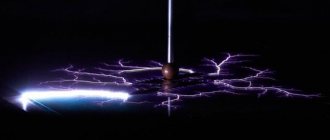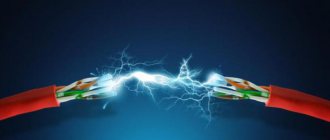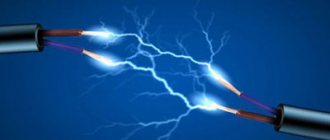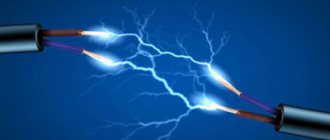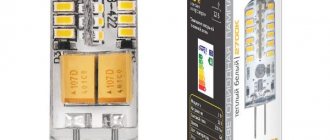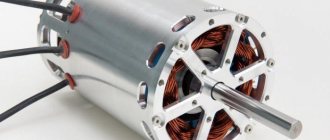Which electric current is better: direct or alternating current?
To answer this question, you need to evaluate their advantages and disadvantages in the following main areas: generation, transmission, distribution and consumption of electricity. Simply put, you need to answer the following questions. Which type of current is easier and cheaper to obtain, then transmit it over a long distance, and then distribute the electricity between consumers. What type of energy consumers are more efficient? Today, the vast majority of electrical energy produced or generated in the world will come from alternating current. And first of all, this is due to the fact that alternating current is easier to convert from a lower voltage to a higher one and vice versa, that is, it is easier to transform.
Unfortunately, it is not yet possible to base the production of high-power electrical energy in the places where we would like, that is, directly next to consumers. For example, a powerful hydroelectric power station can only be built on a deep river, and even then not in every place. And the end consumer can be located hundreds or thousands of kilometers from the power plant. Therefore, it is very important to provide such conditions as to minimize power losses in the power transmission line wires. In this case, electricity losses decrease with increasing voltage. Let's look at this in more detail. Suppose there is a certain power plant, or rather its generator, that produces a power of 1000 kW and we need to transfer this power to a consumer who is located at a distance, for example, 100 km from the generator.
For comparison, we will transmit electrical energy at voltages of 10 kV and 100 kV. For given power and voltages, we determine the magnitude of the currents flowing in the wires.
I1 = P/U1 = 1000 kW/10 kV = 100 A.
I2 = P/U2 = 1000 kW/100 kV = 10 A.
As we see, when the voltage increases by 10 times, the current also decreases by 10 times.
Electricity losses in power transmission line wires and not only in them are determined by the square of the current flowing in them and the resistance of the wire itself. For simplicity of calculation, we assume the resistance of the wires to be 10 ohms. Let's calculate the power losses for both cases.
Ppot1 = I12∙R = 1002∙10 = 100000 W = 100 kW.
Ppot2 = I22∙R = 102∙10 = 1000 W = 1 kW.
Now, as we see, with an increase in voltage by 10 times, electricity losses are reduced by 100 times! At lower voltages, the share of losses in the wires is 10% of the power supplied by the generator. And at higher voltages this share is only 0.1%. Therefore, a very important parameter for comparing types of current is the ability to increase the voltage and then reduce it at the end points.
It would be possible not to increase the voltage, but to use thicker wires to reduce losses, but this approach is not economically justified, since copper wires cost money.
It would also be possible not to increase the voltage of the generator, but to create a generator that would immediately produce high voltage. But here difficulties arise in the manufacture of such generators. The difficulties are mainly associated with the insulation of the high-voltage elements of the generator. In short, it is much easier and cheaper to make a high voltage transformer than a generator.
Advantages of AC
The issue of increasing and decreasing alternating voltage at the current level of technical development is much easier to solve than direct electric current.
Such transformations are quite easily carried out using a relatively simple device - a transformer. The transformer has a high efficiency, which reaches 99%. This means that no more than one percent of the power is lost when the voltage increases or decreases. In addition, the transformer allows you to decouple high voltage from lower voltage, which is a very powerful argument for most electrical installations.
The use of a three-phase AC system can further improve the efficiency of the power supply system. To transmit electricity of the same power, fewer wires will be required than with single-phase alternating current. In addition, a three-phase transformer is smaller in size than a single-phase transformer of equal power.
AC electric machines, in particular squirrel-cage asynchronous motors, have a much simpler design than DC motors. The main advantage of three-phase asynchronous motors is the absence of a commutator-brush assembly. This reduces the cost of manufacturing and operating such electrical machines. In addition, due to the absence of a commutator-brush assembly, asynchronous motors have many times more power compared to DC motors.
Bladeless Tesla turbine
Tesla turbine from the museum
Tesla patented this turbine in 1913. The invention of a turbine without blades was essentially forced, since there were no suitable technologies for the manufacture of a turbine with blades, and the aerodynamic theory had not yet been created, so Tesla decided to use the boundary layer effect, rather than the pressure of a substance on the blades, as is now widespread in traditional turbines.
Tesla turbine design
You can often find statements that the efficiency of his turbine can theoretically reach 95%, but in practice at Westinghouse factories such a turbine showed an efficiency of around 20%. Although later, various modifications of the turbine by other inventors brought the efficiency to 40% or more.
Fluid path in a Tesla turbine
The operating principles of the Tesla turbine are explained very well in English in this video:
As of 2016, the Tesla turbine has not seen widespread commercial use since its invention. So far, it has managed to find a narrow application in pumps. This is primarily due to the fact that the disks inside the turbine are greatly deformed during operation and this affects the overall efficiency of the turbine. Although technological searches are now ongoing to solve all the problems that arise. More recently, the issue of disc deformation has been partially resolved using new materials such as carbon fiber.
Disadvantages of DC
The following shortcomings follow from the above.
- The difficulty of increasing and decreasing voltage, that is, converting DC electricity. This is primarily due to the complexity of the converter designs. Because powerful semiconductor switches designed for high voltage are needed. The absence of which leads to a large number of series and parallel connected semiconductor devices. As a result, the reliability of the entire converter decreases, the cost increases and power losses increase.
- Electric machines have a more complex design, therefore they are less reliable and more expensive, both in production and in operation.
- Difficulties in decoupling high and low voltages.
Voltage formula
There is a formula in physics, although it has no practical application. The official formula is written like this.
voltage formula
Where
A is the work done by the electric field to move a charge along a section of the circuit, Joules
q - charge, Coulomb
U—voltage on a section of the electrical circuit, Volts
In practice, the voltage across a section of a circuit is derived through Ohm's law.
It will be interesting➡ How to check the voltage with a multimeter?
voltage from Ohm's law
Where
I - current, Amperes
R - resistance, Ohms
Disadvantages of AC
- The most important disadvantage of alternating current is the presence of reactive power. As is known, a capacitor and an inductor exhibit their reactive properties only in alternating current circuits. Simply put, the coil and capacitor create reactance to AC current, but do not consume it. As a result of this, of the total power supplied by the alternator, part of the power is not spent on performing useful work, but only circulates uselessly between the generator and the load. This power is called reactive power and is harmful. Therefore, they try to minimize it.
However, most loads - motors, transformers and the wires themselves - are inductive elements. And the greater the inductance, the greater the proportion of reactive power from the total and this must be dealt with.
- The second main disadvantage of alternating current is that it does not flow across the entire cross-section of the conductor, but is displaced closer to its surface. As a result, the area through which electric current flows decreases, which in turn leads to an increase in the resistance of the conductor and an increase in power losses in it.
The higher the frequency, the more current is displaced to the surface of the conductor and, ultimately, the higher the power loss.
Invention of radio and radio control
Tesla shows off its radio-controlled boat
The 20th century is extremely rich in various inventions and technical innovations. Many were invented in parallel in various variations, while some patented their inventions, while others could not or did not want to do this for some reason. Therefore, it is quite difficult to establish who was the first to invent radio. For example, in the USA, radio is believed to have been invented by David Hughes, Thomas Edison and Nikola Tesla, who made relevant technical contributions to this invention; in Germany it is believed that radio was invented by Heinrich Hertz, and in France by Edouard Branly; In Belarus, Yakov Narkevich-Iodka is considered the inventor of radio; In Brazil it is believed that the inventor of radio was Landel de Mourou; in England - Oliver Joseph Loggia; in the USSR, it was generally accepted to consider Alexander Stepanovich Popov as the inventor of radio, and so on for many more countries. Gugliermo Marconi should not be considered the inventor of radio as a technology or a complete system, but as the creator of the first commercially successful implementation of a radio system.
All of their patents and inventions appeared between 1880-1895 and they were all involved in the study of radio waves. Simply put, they were all inventors of radio to one degree or another, contributing to the development of the theory of information transmission.
But what did Tesla do? And he did a lot too. He described the principles by which it was possible to transmit a radio signal over long distances, conducted a number of his own experiments on signal transmission, and also created the first radio-controlled boat, which he demonstrated at an electrical exhibition in 1898. True, he did not believe that communication was possible using radio waves.
Nikola Tesla's radio-controlled boat
One of the pages of the patent for Nikola Tesla's radio-controlled boat
In the video you can see the boat, which was assembled in 2015 in the likeness of the one Tesla had:
The boat was controlled using radio control. Tesla demonstrated this boat in 1898 at the Electrical Exhibition at Madison Square Garden. There she made a splash. Imagine the people of that time who did not understand how Tesla controlled the boat, ordering it to sail to this or that place. Apart from the word “magic,” it was difficult to find anything here for the average person of that time.
Although newspapermen of that time immediately began to call Tesla’s invention a “radio-controlled torpedo” (apparently due to the fact that at that time Thomas Edison was trying to invent a similar torpedo and sell it to the military), Tesla himself did not aim at war. In 1900, Centure magazine interviewed the inventor, where he said that the purpose of his invention was an attempt to create “artificial intelligence,” since modern machines simply borrow the human mind and respond only to his orders. Tesla believed that one day people would be able to create a machine with a mind of its own. Well, after more than 100 years, we can still say that we have not created such a machine.
Later during World War II, the Nazis would use radio controls to create remote-controlled tanks.
We also recommend an interesting article about modern Russian developments in the field of combat robotics.
Advantages of DC
- The main advantage of DC electrical energy is the absence of reactive power. This means that all the power generated by the generator is consumed by the load minus losses in the wires.
- Direct current, unlike alternating current, flows throughout the entire cross-section of the conductor.
These two points lead to the fact that if the same power is transmitted at equal voltages with direct and alternating currents, then the power losses of electricity with direct current would be almost half as much as with alternating current.
In addition, if we consider such consumer electronic devices as laptops, computers, televisions, etc., then they all have power supplies that convert alternating voltage 220 V (230 V) into a direct voltage of a lower value. And such transformations are associated with a partial loss of power.
In addition, as mentioned earlier, a three-phase asynchronous motor (IM) can be connected directly to a 380 V network, which is quite justified in the case when it is not necessary to change the operating mode of the motor. But if it is necessary to change the rotation frequency of its shaft, then it is necessary to apply voltage to the stator windings, the frequency and amplitude of which must change proportionally, according to Kostenko’s law. For this, three-phase autonomous inverters (AI) are used, most often voltage inverters. Such inverters must be powered from a constant voltage source.
It should also be noted that recently solar batteries that generate direct current have begun to be used very widely. In addition, the power of rechargeable batteries has increased significantly and the capacity of supercapacitors, which also belong to direct current sources and are finding more and more practical applications every day, has increased.
Tesla Tower
Tesla did not stop at the wireless lighting system and went further. He decided that it was possible, in principle, not to use high-voltage wires to transmit current and transmit all electricity through air. To do this, he wanted to build a huge experimental facility in New York, known as the Tesla Tower or Wardenclyffe Tower. Later, while conducting his experiments and observations on lightning, Tesla came to the erroneous conclusion that he could use the entire globe to conduct current.
One of the pages of the Tesla Tower patent
He received money for construction from the then famous financier J.P. Morgan, to whom he informed that the tower would be used for transatlantic wireless telephony and broadcasting, from which Morgan planned to make money. In fact, it was the first such tower of its kind.
Construction of the tower began in 1901 and continued until 1903. A second receiving tower was planned to be built near Niagara Falls. When the first tower in Wardenclyffe was almost completed, Morgan realized that wireless transmission of electricity could lead to the collapse of the entire market in which he had investments (he owned the Niagara Hydroelectric Power Station), so he stopped financing Tesla's project. In May 1905, Tesla also lost his patent income upon expiration, so he went bankrupt and was never able to complete the second tower.
How does the Tesla Tower work?
The tower at Wardenclyffe was a huge Tesla coil, about 60 meters high, with a large copper sphere on top. The tower generated lightning up to 40 meters long, and the thunder from the released electricity generated thunder that could be heard 24 kilometers from the tower. The weight of the tower reached 55 tons, and the diameter was 21 meters.
Wardenclyffe Tower from the inside
In 1905, a test launch was carried out, which had a shocking effect. The newspapers wrote that Tesla managed to light up the sky over the ocean for thousands of miles. Around the tower itself, horses received electric shocks and even the wings of butterflies became electrified to such an extent that “St. Elmo’s Fire” (corona discharge) could be seen around them.
Unfortunately, the tower was demolished in 1917.
Conclusions: direct or alternating current
Despite all the advantages of direct current, the significant complexity caused by the conversion of large powers, mainly affecting the difficulty of increasing and decreasing the direct voltage, negates the above advantages. Therefore, until semiconductor switches of enormous power and corresponding converters based on them are developed, alternating current remains out of competition. In addition, four-quadrant converters or active rectifiers are now being used to compensate for the reactive component of the load, which makes it possible to obtain a power factor equal to almost unity. This eliminates the consumption of reactive power.
As you can see, there is no clear answer to the question of which current is better: direct or alternating. All advantages and disadvantages for a particular case should be compared.
